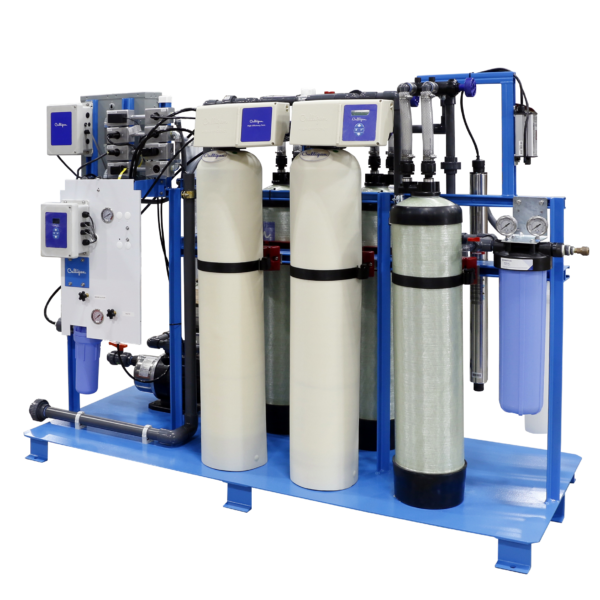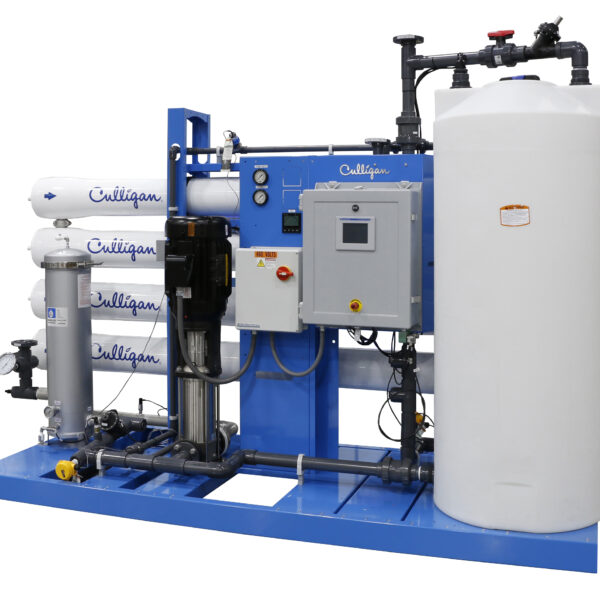- Customer:
- A Major Petroleum Refinery
- Description of Business:
- Oil Refinery
- Challenge:
- The company was looking to replace a hot lime softener.
- Solution:
- The solution included multi-media filters, a chemical treatment system, a re-pressurization system, reverse osmosis membranes and a polishing zeolite softener from the Culligan® Industrial Solutions Arsenal.
- Result:
- The Culligan® Industrial Solution helped the facility increase equipment and process efficiency, reduce boiler treatment chemicals, reduce maintenance costs and waste.
A major petroleum refinery was looking to replace a hot lime softener. Naturally occurring minerals such as Calcium, Magnesium and Silica can cause scale in steam boilers and other types of equipment used in refinery operations. Scale deposits in steam boilers can reduce equipment efficiency and increase energy, chemical, disposal and maintenance costs. Hot lime softening is a traditional treatment technology used to reduce hardness and alkalinity from boiler feed water. However, the current process posed several challenges for the refinery. First, the refinery was looking to increase the energy efficiency and reduce costs associated with boiler blow down requirements. Second, the refinery wanted to lower the hot lime process softener maintenance and the associated equipment plugging and cleaning that was required. Third, the refinery wanted to avoid handling of lime slurry and related waste disposal costs. Forth, the refinery was looking to reduce the boiler treatment chemicals associated with the current process.
After some research, the company had identified reverse osmosis as an alternative to the traditional hot lime softening process. After evaluating its options, the company picked Culligan to design and build the water treatment system to replace the current hot lime softener.
Benefits of Culligan® Industrial Solutions

The Culligan® Industrial Solution helped the facility increase equipment and process efficiency, reduce boiler treatment chemicals, reduce maintenance costs and waste. The most significant benefit was the reduction in boiler blow down as a result of the increase in the cycles of concentration from 7.5 cycles to 65 cycles. The energy savings as a result of the reduction in boiler blow down was approximately $165,000 per year. The reduction in boiler chemicals helped the company save approximately $36,000 per year. Furthermore, maintenance and waste disposal savings were approximately $20,000 and $4,300 per year respectively. The net annual savings from the Culligan Industrial Solution was approximately $200,000.
Solution
Culligan® was able to provide an innovative solution that resulted in significant ROI savings. With input from the customer and Culligan’s discovery process, Culligan® proposed a skid mounted water treatment system. The solution included multi-media filters, a chemical treatment system, a re-pressurization system, reverse osmosis membranes and a polishing zeolite softener from the Culligan® Industrial Solutions Arsenal.
The first component of the Culligan® Industrial Solution is the multi-media filters. The feed water is first passed through two multi-media filters. The multi media filters contain layers of media, which reduce suspended solids and prepares the feed water for further treatment down the process.
The second component of the solution is the chemical treatment system. Chemicals are added to the water to reduce silica, which scale reverse osmosis membranes. Furthermore, chemical treatment was also used to reduce free chlorine, which can damage the reverse osmosis membranes.
The third component is the re-pressurization system that increases the feed pressure to approximately 300 psig before the feed water enters the reverse osmosis membranes. The application of pressure to the influent water forces the water through the semi-permeable membrane.
The fourth component is the reverse osmosis membranes. Reverse Osmosis is based on the ability of a semi-permeable membrane to separate dissolved solids from water. Treated water (permeate) is separated from the concentrate solution (reject). Osmotic membranes perform the best level of filtration and are barriers to salts and to organic substances including micro-contaminants. Reverse Osmosis also reduces the need for chemical regenerants used in the previous hot lime softening process.
The fifth component of the system is the zeolite softener. The zeolite softener is the final polishing step before the water enters the boilers.




